Additional Information Release
Education and Training Experience, Australia 2005 (Data Cubes Only) (6278.0) is expected to be released on Wednesday 13 September 2006.
Data Cubes, in excel format, for Australia and each of the States have been released. These Data Cubes provide additional data and no other changes to the existing products have been made.
NOTES
ABOUT THIS PUBLICATION
This publication presents results from the Survey of Education and Training (SET), which was conducted nationally by the Australian Bureau of Statistics (ABS) from May to August 2005. Information was collected by personal interview from individuals on their participation in education and training and on their educational attainment.
This publication contains a cross-section of results relating to education and training. The Explanatory Notes provide information about the survey design and methodology, the quality and interpretation of survey results, and information about other products and services available or planned.
CHANGES IN THIS ISSUE
The scope of the Survey of Education and Training was expanded in 2005. Information was collected from persons aged 15-69 years, with limited information collected from those aged 70 years and over. For further details, see paragraphs 45-48 of the Explanatory Notes.
The content of SET also changed slightly in 2005. Study not leading to a qualification, household and personal income, and reasons for undertaking most recent non-school qualification and current study were collected for the first time. The definition of internal/external training courses was no longer used, resulting in some different information being available for work-related training courses. Minor changes to the collection of employment information were made to align with ABS standards. Further details can be found in the Explanatory Notes.
'Employees excluding owner managers of incorporated enterprises' replaces 'wage or salary earners' used in previous editions of this publication. These groups are generally comparable, see Explanatory Notes for more details.
The ordering of the tables in this publication differs from that in the 2001 publication.
CLASSIFICATION OF EDUCATION
The Australian Classification of Education (ASCED) (cat. no. 1272.0) was introduced into ABS collections in 2001. It replaced a number of education classifications used prior to 2001 for data from the various sectors of the Australian education system, including the Australian Bureau of Statistics Classification of Qualifications (ABSCQ) (cat. no. 1262.0). ASCED comprises two classifications: Level of Education and Field of Education. For further details, see paragraphs 34-39 of the Explanatory Notes.
ROUNDING
As estimates have been rounded, discrepancies may occur between the sums of the component items and totals.
INQUIRIES
For further information about these and related statistics, contact the National Information and Referral Service on 1300 135 070 or Terri Jamieson on Canberra (02) 6252 5267.
SUMMARY OF FINDINGS
EDUCATION AND TRAINING OVERVIEW
Education and training contribute to personal and economic well-being, and to Australia's knowledge base. Education, which leads to a qualification, may be provided by educational institutions and organisations, as well as through the workplace. Learning can also be less formal, and includes unaccredited (short course) workplace training and other study not resulting in a qualification.
In 2005, 22% of persons aged 15 to 69 years were enrolled in a course of study. Some 37% of persons aged 15 to 69 years had completed at least one work-related training course in the 12 months prior to the survey.
About half the population aged 15 years and over had a vocational or higher education qualification. Of those in, or marginally attached to the labour force aged 15 to 64 years, the proportion with such qualifications increased from 57% in 2001 to 61% in 2005, while those who had completed a work-related training course at any time in the last 12 months rose over the same period from 45% to 48%.
PARTICIPATION IN EDUCATION
All study in 2005
About 3.2 million persons aged 15 to 69 years were enrolled to study in 2005. Of those who were studying:
- 54% were aged 15-24 years
- 54% were female
- 33% were employed full-time and 31% were employed part-time
- 73% were living in the major cities of Australia.
PERSONS AGED 15-64 YEARS ENROLLED IN A QUALIFICATION, Level of education-2001 & 2005
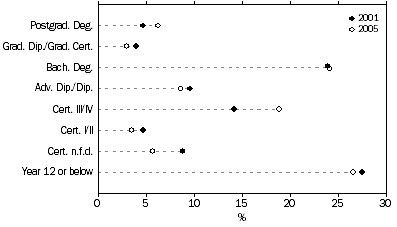
The number of persons aged 15 to 64 years studying either at school or for a non-school qualification was 2.7 million in 2005 compared to 2.5 million in 2001. Proportionately more persons were studying at a Certificate III or IV level in 2005 (19%) than in 2001 (14%). Management and commerce was the most common field of study in both years (21% in 2005, up from 19% in 2001). Those studying in the field of Information technology, on the other hand, declined from 6% in 2001 to 4% in 2005.
Schooling
Of those aged 15 to 69 years studying in 2005, 23% (725,400 persons) were studying at Year 12 level or below. Most of these students were aged 15 to 24 years, although a small proportion (1%) were in the older age groups, suggesting they had probably returned to school level study after a period of time.
Study leading to a non-school qualification
Approximately 2 million persons were enrolled in non-school qualification study during 2005, which was 63% of all those enrolled in a course of study. Of these, 45% were studying for a Bachelor Degree or higher level qualification. A further 38% were undertaking Certificate level study, of which two-thirds were at Certificate III or IV level.
Of those undertaking non-school qualification study, 77% were enrolled for job-related reasons and 60% were receiving at least one form of financial support for their study.
Study not leading to a qualification
Of all persons aged 15 to 69 years studying during 2005, 14% were undertaking a course not leading to a qualification, including bridging courses, recreational and personal enrichment courses, as their only course of study. These students were more likely to be female (68%) and in the older age groups (91% aged 25 years and over).
EDUCATIONAL ATTAINMENT
Highest educational attainment
Educational attainment is seen as a key factor contributing to individual success and Australia's economic prosperity. The level of educational attainment is a component of the stock of skills or competencies available in the population. Of the population aged 15 years and over in 2005, 31% reported Year 10 or below (or its equivalent) as their level of highest educational attainment, and 23% reported Year 11 or Year 12 as their highest educational attainment. A further 18% had a Bachelor Degree or higher level qualification, and 16% had a Certificate III or IV.
PERSONS AGED 15+ YEARS, Level of highest educational attainment
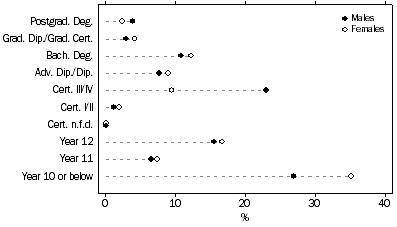
Earnings
There is a relationship between educational attainment and average earnings. Excluding owner managers of incorporated enterprises (who drew a wage or salary), the average weekly earnings of full-time employees was $790 for those whose level of highest educational attainment was Year 10 or below, compared to $1,624 for those whose level of highest educational attainment was a Postgraduate Degree. The earnings of males were higher than the earnings of females across all educational attainment categories.
Full-time employees excl. owner managers of incorporated enterprises aged 15+, Average weekly earnings by Level of highest educational attainment
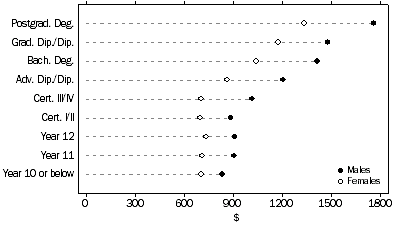
Non-school qualifications
Due to factors such as technological change and the changing needs of industry, individuals are increasingly required to achieve a qualification beyond primary or secondary education levels. Non-school qualifications include vocational and higher education qualifications, and may be completed by persons after, or while still attending school.
Of those aged 15-69 years:
- 34% had one non-school qualification
- 13% had two non-school qualifications
- 8% had three or more non-school qualifications.
Most multiple qualification holders held qualifications at different levels of education (58%), and many had also attained qualifications in unrelated fields of study (48%).
While people may choose to undertake education or training at any age, those who have reached the age of 25 years are most likely to have completed the initial stages of their education. In 2005, of those aged 25 to 69 years, 60% (6.9 million persons) had at least one non-school qualification. The likelihood of having a non-school qualification varied substantially by age within this group. Of those aged 25 to 44 years, 66% had at least one non-school qualification. In contrast, of those aged 45 to 69 years, 55% had at least one non-school qualification.
Non-school qualifications in the labour force
The changing nature of work has led to a greater number and higher level of non-school qualifications in the labour market. In 2005, of persons in, or marginally attached to the labour force aged 15 to 64 years, 62% had a non-school qualification, compared with 57% in 2001, 52% in 1997 and 46% in 1993.
PERSONS AGED 15-64 YEARS IN, OR MARGINALLY ATTACHED TO, THE LABOUR FORCE, Highest non-school qualification-1993-2005
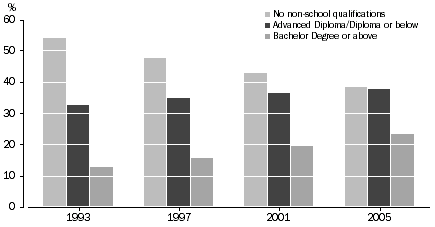
There has also been a change in the distribution of non-school qualifications, mostly influenced by a growth in persons with a Bachelor Degree or higher level qualification. Between 1993 and 2005, the proportion of those with a Bachelor Degree or higher level qualification increased from 13% to 23%, while the proportion of those with an Advanced Diploma/Diploma or below increased from 33% to 38%.
WORK-RELATED TRAINING
In this survey, work-related training courses comprised structured learning activities undertaken primarily to obtain, maintain or improve employment-related skills or competencies in the 12 month period prior to the survey. These courses may have been undertaken by persons in and outside the labour force and included training seminars, workshops and conferences, audio visual presentations, lectures and self-paced tutorials of a structured nature.
In the 12 months prior to the survey, 5.3 million persons aged 15 to 69 years (of whom 54% were male) completed one or more work-related training courses. Information was collected for up to four work-related training courses per person in this group. In total, 11.2 million work-related training courses were reported.
PERSONS AGED 15-69 YEARS, Number of training courses completed
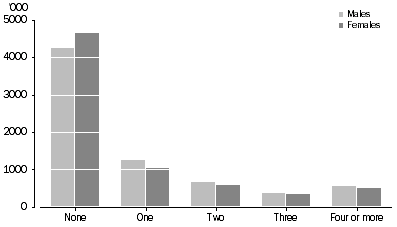
Overall, 37% of persons aged 15 to 69 years had completed one or more work-related training courses. Persons in the Australian Capital Territory had the highest rate of work-related training course completion (50%), while Tasmania had the lowest rate (32%). Variation by state and territory in the proportions of training courses undertaken can be influenced by employer size and sector.
Employment and work-related training
Almost 55% of persons aged 15 to 69 years who were employed full-time at the time of the survey completed at least one work-related training course in the last 12 months. The rate was 41% for persons employed part-time and 29% for unemployed persons.
Overall, of those in, or marginally attached to the labour force aged 15 to 64 years (10.6 million persons), 48% had completed at least one work-related training course in 2005. The proportion of those who completed such courses has risen consistently, from 30% in 1993, 42% in 1997 and 45% in 2001. The proportion of work-related training completed has increased across almost all age groups, for both males and females.
Training hours
While the proportion of persons completing a work-related training course has been increasing over time, the total number of training hours and average training hours per course declined (for employees excluding owner managers of incorporated enterprises aged 15 to 64 years). The total work-related training hours was 139.0 million hours in 2005, compared to 143.4 million hours in 2001, and 148.6 million hours in 1997 (based on the four most recent courses completed). From 1997 to 2001 the average duration of work-related training courses completed fell from 20.6 hours to 17.4 hours. This fell again in 2005 to 14.7 hours.
Financial support
Fifty per cent of reported work-related training courses were employee training courses organised and delivered by the course participant's employer (see Glossary for further details). A further 27% of course participants received some form of financial support.
For most work-related training courses completed by employees excluding owner managers of incorporated enterprises, the participant did not incur any personal financial cost for the training course (94%), whereas the participant was more likely to incur costs for work-related training courses if they were working in their own business (41%). The average cost for participants was highest for courses completed while participants were working in their own business ($535), compared to $388 for all work-related training courses.
Field of work-related training
Overall, 30% of the 11.2 million reported work-related training courses were in the Management and professional field. Other commonly reported fields of work-related training were Health and safety (21%), and Technical and para-professional (14%).
WORK-RELATED TRAINING COURSES COMPLETED BY PERSONS AGED 15-69 YEARS, Field of training
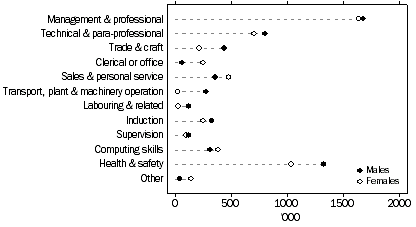
Training outcomes
For 90% of reported work-related training courses completed by employees excluding owner managers of incorporated enterprises, participants considered the skills gained from the training course were transferable, in that they could be used in a similar job with another employer. Work-related training courses were assessed by persons as having helped them to obtain a pay rise or promotion for 7% of work-related training courses, regardless of whether or not the training was undertaken to help obtain a pay rise or promotion.
Barriers to training
Of persons aged 15 to 69 years not at school, 2.8 million persons (21%) wanted to undertake work-related training or additional work-related training but did not do so. The main reason provided for not undertaking training was 'Too much work' (19%) followed by 'No time' (16%).
 Print Page
Print Page
 Print All
Print All